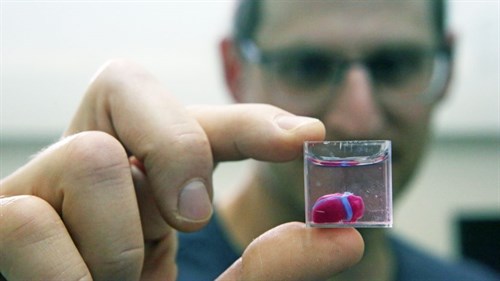Scientists Print 3D Heart Using Patient's Tissue

Photo by FLASH90
In recent years, 3D printing has evolved dramatically. Being used to create anything from figurines and pieces of technology to buildings and even food. It still has a long way to go before it can be used regularly in the medical field, but scientists are now one step closer to making this dream a reality.
Cardiovascular disease (CVD) is the number one killer of adults in the world, and in 2016 it was estimated that 17.9 million deaths were associated with CVD. (World Health Organization) Once CVD has progressed into the final stages, the only treatment option is a heart transplant, but because of the lack of donors the waiting period for the surgery is long and by the time a donor is found it can be too late for the one needing the transplant. Because of this, scientists and doctors have to find ways to postpone the transplant or prevent the need for it altogether. Most will end up repairing the existing tissue with an implanted material, but there is a risk of the material being rejected by the body and creating more damage, so scientists are still on the hunt for a solution.
A group of scientists at Tel Aviv University has made progress in finding a solution to artificially replicating human tissue and were able to ‘print’ a small human heart.“This is the first time anyone anywhere has successfully engineered and printed an entire heart replete with cells, blood vessels, ventricles, and chambers."-Lead researcher Prof. Tal Dvir
In order for this process to work, scientists start by taking a biopsy of fatty tissue from the patient then separate cellular material from noncellular material. Researchers will reprogram the cells of the fatty tissue to create pluripotent stem cells, which have the ability to develop into the cells needed to create a heart. The noncellular materials, consisting of structural components like glycoproteins and collagen are modified to turn them into “bioink.” The bioink is then mixed with the stem cells. Scientists can use the differentiated cells, cardiac or endothelial cells, to create cardiac patches, including blood vessels. To read a more in-depth analysis of the methods used, you can read the recently published paper in the journal Advanced Science.
The 3D printed heart created is about the size of a rabbit’s heart, but scientists believe the same technology is required for human hearts. "This heart is made from human cells and patient-specific biological materials. In our process, these materials serve as the bioinks, substances made of sugars and proteins that can be used for 3D printing of complex tissue models...People have managed to 3D-print the structure of a heart in the past, but not with cells or with blood vessels. Our results demonstrate the potential of our approach for engineering personalized tissue and organ replacement in the future," Prof. Dvir says.
Technology is still far away from being able to replace human transplants Since it is now proven that replication is possible, Prof. Dvir says that the next big step is to get them to behave like hearts, need to be developed further and form a pumping ability to go along with the contraction they can already perform.
“Maybe, in 10 years, there will be organ printers in the finest hospitals around the world, and these procedures will be conducted routinely.”-Prof. Tal Dvir
